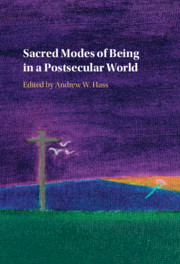Book contents
- Sacred Modes of Being in a Postsecular World
- Reviews
- Sacred Modes of Being in a Postsecular World
- Copyright page
- Contents
- Figures
- Contributors
- Acknowledgements
- Introduction
- Part I Jasper’s Sacred Mode of Being
- Part II Theology’s Cultural Mode of the Sacred
- Part III Culture’s Theological Mode of the Sacred
- Chapter 7 The Interdisciplinary Nature of Literature and Theology
- Chapter 8 William Blake as leitourgos
- Chapter 9 Bodies Dead or Alive?
- Chapter 10 The Desert Is in the Words We Speak
- Afterword
- Bibliography
- Index
Chapter 7 - The Interdisciplinary Nature of Literature and Theology
from Part III - Culture’s Theological Mode of the Sacred
Published online by Cambridge University Press: 07 September 2021
- Sacred Modes of Being in a Postsecular World
- Reviews
- Sacred Modes of Being in a Postsecular World
- Copyright page
- Contents
- Figures
- Contributors
- Acknowledgements
- Introduction
- Part I Jasper’s Sacred Mode of Being
- Part II Theology’s Cultural Mode of the Sacred
- Part III Culture’s Theological Mode of the Sacred
- Chapter 7 The Interdisciplinary Nature of Literature and Theology
- Chapter 8 William Blake as leitourgos
- Chapter 9 Bodies Dead or Alive?
- Chapter 10 The Desert Is in the Words We Speak
- Afterword
- Bibliography
- Index
Summary
This chapter explores theology as an answer to the question of how to preserve a Chinese way of thinking while entering into conversation with other world systems of thought. It looks at how theology necessitates an interdisciplinary approach in engagement with literature, especially the study of the classics/scriptures. It interrogates the translation of Western poetry into Chinese as a process accelerating the loss of distinction between “shi” (poetry) and “jing” (scripture). This loss will alter our late modern understanding of the sacred as something that is both poetic and scriptural. The chapter explores the implications this notion of the sacred has for the distinctions made within “religion” itself. If those in the West often feel confused at the notion of Confucianism, Buddhism and Taoism as three religions in one, and fail to recognize that the Chinese do not perceive these three religions as alternatives, so too poetry and scripture, or art and theology, could be seen as “interpenetrating fields of force” (Hick). The chapter ends by reflecting on the significance such interpenetrating fields might have for a “non-religious Christianity” and even an “atheist theology”.
Keywords
- Type
- Chapter
- Information
- Sacred Modes of Being in a Postsecular World , pp. 137 - 163Publisher: Cambridge University PressPrint publication year: 2021

